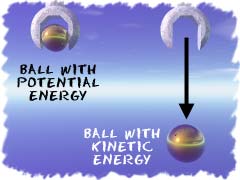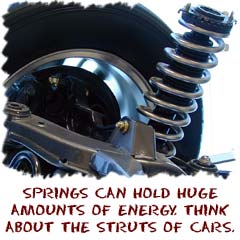Energy Around Us
We use the concept of energy to help us describe how and why things behave the way they do. We talk about solar energy, nuclear energy, electrical energy, chemical energy, etc. If you apply a force to an object, you may change its energy. That energy must be used to do work, or accelerate, an object. Energy is called a scalar; there is no direction to energy (as opposed to vectors). We also speak of kinetic energy, potential energy, and energy in springs. Energy is not something you can hold or touch. It is just another means of helping us to understand the world around us. Scientists measure energy in units called joules.Active Energy vs. Stored Energy
 Kinetic and potential energies are found in all objects. If an object is moving, it is said to have kinetic energy (KE). Potential energy (PE) is energy that is "stored" because of the position and/or arrangement of the object. The classic example of potential energy is to pick up a brick. When it's on the ground, the brick had a certain amount of energy. When you pick it up, you apply force and lift the object. You did work. That work added energy to the brick. Once the brick is in a higher/new position, we would say that the increased energy was stored in the brick as PE. Now the brick can do something it couldn't do before; it can fall. And in falling, can exert forces and do work on other objects.
Kinetic and potential energies are found in all objects. If an object is moving, it is said to have kinetic energy (KE). Potential energy (PE) is energy that is "stored" because of the position and/or arrangement of the object. The classic example of potential energy is to pick up a brick. When it's on the ground, the brick had a certain amount of energy. When you pick it up, you apply force and lift the object. You did work. That work added energy to the brick. Once the brick is in a higher/new position, we would say that the increased energy was stored in the brick as PE. Now the brick can do something it couldn't do before; it can fall. And in falling, can exert forces and do work on other objects.
Season of Springs
The study of springs is a whole section of physics. A spring that just sits there doesn't do much. When you push on it, you exert a force and change the arrangement of the coils. That change in the arrangment stores energy in the spring. It now contains energy and can expand and do work on other things. Anything that is elastic (can change its arrangement and then restore itself), such as a rubber band, can store energy in the same way. A rubber band can be stretched and then it is ready to do something. That stretching involves work and increases the potential energy. You can flatten a solid rubber ball and it will want to bounce back up. You can also pull the drawstring of a bow and the work done stores the energy that can make the arrow go flying. Those are all examples of your putting energy in, and then something happening when the energy comes out.
A rubber band can be stretched and then it is ready to do something. That stretching involves work and increases the potential energy. You can flatten a solid rubber ball and it will want to bounce back up. You can also pull the drawstring of a bow and the work done stores the energy that can make the arrow go flying. Those are all examples of your putting energy in, and then something happening when the energy comes out.
Gases Storing Energy
Gases? What can they do? Gases are great because they can compress and expand. They act as if they were elastic. If the pressure increases and compresses gas molecules, the amount of stored energy increases. It's similar to a spring, but slightly different. Eventually that energy in the compressed gas can be let out to do something (work).In your car, there are shock absorbers. Some shocks have compressed gas in the cylinders rather than springs. The energy in those cylinders keeps your car from bouncing too much in potholes. Think about wind. Wind is caused because of pressure differences in the atmosphere. When the wind blows it can do anything - turn windmills, help birds fly, make tornadoes, and do all types of work.
Or search the sites for a specific topic.
- Overview
- Forces
- Vectors
- Laws of Motion
- Energy of Motion
- Velocity
- Momentum
- Friction
- Gravity
- Work
- More Topics

Law of Conservation of Energy (NASA-eClips Video)

Useful Reference Materials
Encyclopedia.com:http://www.encyclopedia.com/topic/energy.aspx#2
Wikipedia:
http://en.wikipedia.org/wiki/Energy
Encyclopædia Britannica:
http://www.britannica.com/EBchecked/topic/187171/energy





